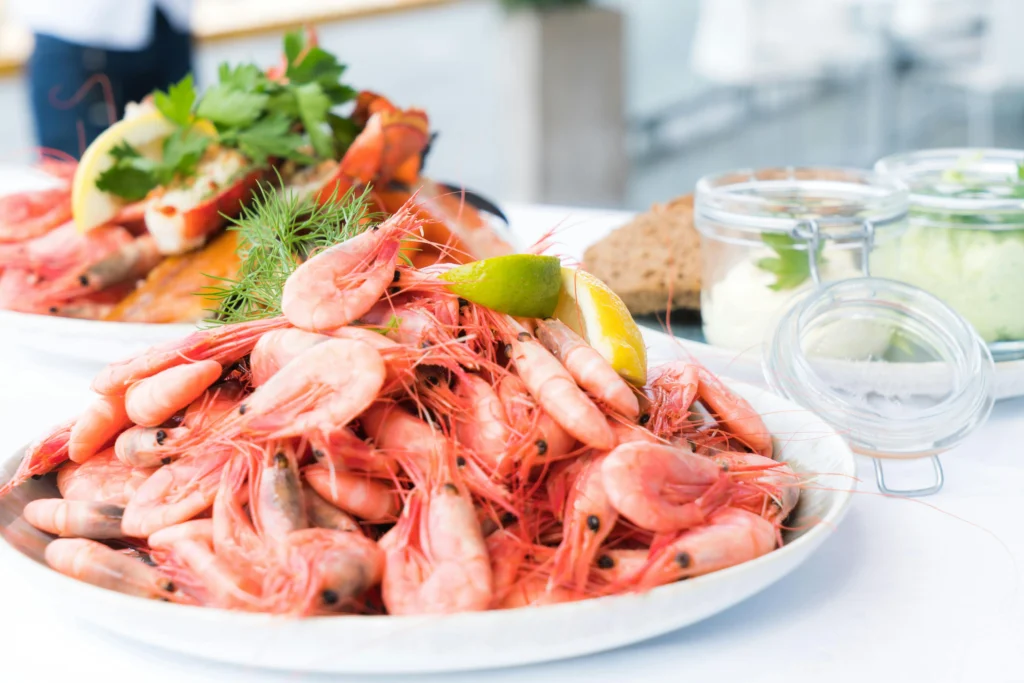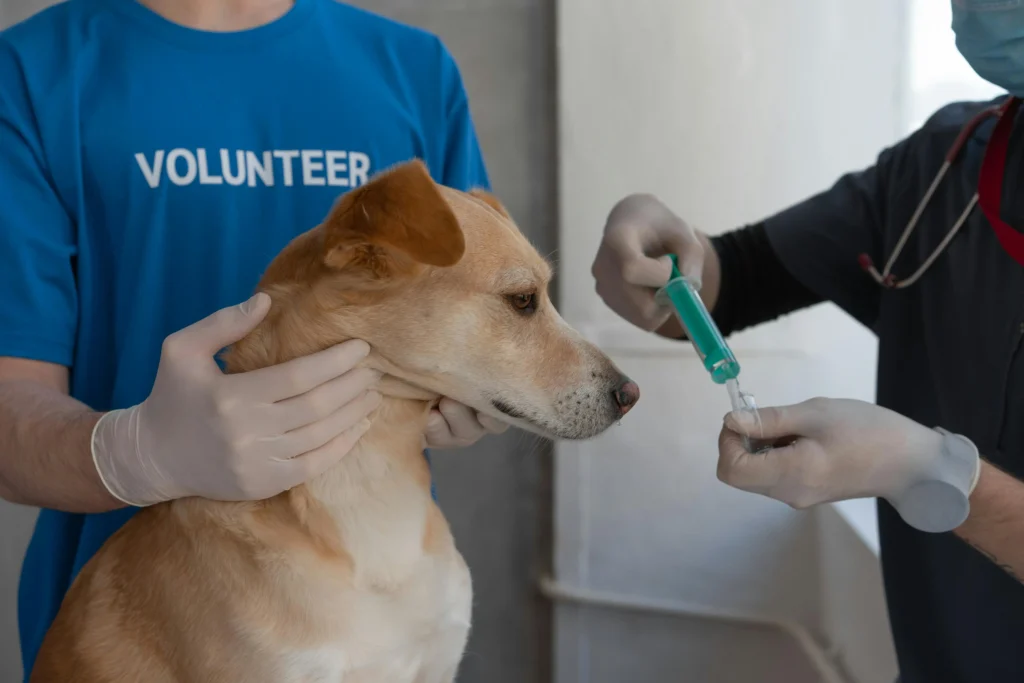As a loving dog owner, you might often wonder, “Can dogs eat shrimp?” Whether you’re preparing a seafood feast or enjoying shrimp yourself, it’s natural to think about sharing some with your furry friend. While shrimp is a healthy option for humans, is it the same for dogs? In this guide, we’ll explore everything you need to know about shrimp and whether it’s safe for dogs to consume. From the nutritional benefits to the risks involved, we’ll provide an in-depth look at the pros and cons of feeding shrimp to your dog.
Table of Contents
What is Shrimp?
Shrimp is a type of shellfish commonly found in both saltwater and freshwater environments. It’s a beloved seafood around the world, praised for its versatility in various dishes. For humans, shrimp is an excellent source of lean protein and contains essential vitamins and minerals such as omega-3 fatty acids, iodine, and vitamin B12. However, shrimp isn’t just food for us if prepared correctly, it can also be shared with your dog. But can dogs eat shrimp safely without any concerns? Let’s find out.
Can Dogs Eat Shrimp?
The quick answer is yes, dogs can eat shrimp, but there are some important rules to follow. Shrimp is not toxic to dogs, but it must be prepared and served properly. You can’t simply throw shrimp into your dog’s bowl and hope for the best. Raw shrimp, seasoned shrimp, and shrimp with shells can pose risks to your pet. So while dogs can enjoy shrimp, it should be cooked, plain, and served in moderation.
The question is not just can dogs eat shrimp, but should dogs eat shrimp regularly? While shrimp offers some health benefits, it’s important to weigh those against the potential risks, especially when considering how often to include it in their diet.

Nutritional Benefits of Shrimp for Dogs
Shrimp is packed with valuable nutrients that dogs need to stay healthy. Here’s a breakdown of the key nutrients found in shrimp:
- Protein: Shrimp is a fantastic source of lean protein. Dogs need protein to maintain strong muscles and overall health.
- Omega-3 Fatty Acids: These fats are essential for skin health, brain function, and joint mobility.
- Vitamins and Minerals: Shrimp is rich in vitamins B12 and E, as well as essential minerals like phosphorus, selenium, and iodine. These help with everything from cell repair to immune function.
Shrimp can be a valuable part of your dog’s diet when provided occasionally and in moderation. But before you rush to feed your dog shrimp, you should consider the health benefits in more detail.
Health Benefits of Feeding Shrimp to Dogs
- Promotes Healthy Skin and Coat: Thanks to its high content of omega-3 fatty acids, shrimp can help keep your dog’s skin and coat shiny and soft. These fatty acids also reduce inflammation, which can help older dogs with joint problems.
- Supports Muscle Growth and Repair: The high protein content in shrimp makes it an excellent snack for dogs that are highly active. Protein helps to maintain muscle mass and aids in the recovery process after exercise.
- Boosts Energy Levels: Shrimp is a low-calorie, nutrient-dense food. While it’s low in fat, the B vitamins it contains help dogs maintain steady energy levels throughout the day.
- Enhances Cognitive Function: Omega-3 fatty acids in shrimp support brain health. Feeding your dog shrimp occasionally can contribute to sharper mental function, especially in older dogs.
But is shrimp always beneficial? While it’s true that dogs can eat shrimp, we need to be aware of the risks before incorporating this shellfish into their diet.
Risks of Feeding Shrimp to Dogs
Even though shrimp can offer health benefits, it’s important to understand that feeding shrimp to dogs comes with its fair share of risks. The most notable dangers include:
- Choking Hazard: Shrimp shells, tails, and even whole shrimp can become choking hazards for dogs. Dogs may not chew food thoroughly, which makes shrimp shells particularly risky.
- High Sodium Content: Store-bought or restaurant-prepared shrimp may contain high levels of sodium, which can lead to dehydration, high blood pressure, and other health problems in dogs.
- Allergic Reactions: Some dogs may be allergic to shrimp. Symptoms of a shrimp allergy can range from mild itching to severe vomiting, swelling, or even anaphylaxis.
While the risks are concerning, you can reduce them by preparing shrimp properly. But many dog owners wonder about raw shrimp: can dogs eat raw shrimp without any harm?
Can Dogs Eat Raw Shrimp?
No, dogs should never eat raw shrimp. Like many other raw animal products, raw shrimp carries a risk of bacterial contamination, especially from Salmonella or Listeria. Consuming raw shrimp could make your dog seriously ill, causing symptoms such as diarrhea, vomiting, and fever. The only way to make shrimp safe for your dog is to thoroughly cook it.

Cooked Shrimp: A Safer Option for Dogs?
Yes, cooked shrimp is far safer than raw shrimp for dogs. Boiling or steaming shrimp kills harmful bacteria and parasites that might be present in raw shrimp. Additionally, cooking shrimp makes it easier for dogs to digest. Remember to serve it plain, without any oils, butter, or seasoning, which can upset your dog’s stomach or lead to more serious issues.
But what about shrimp with seasonings or special sauces? Can dogs eat shrimp when it’s cooked with extra ingredients?
Can Dogs Eat Shrimp with Seasonings?
No, shrimp that has been seasoned with spices, salt, garlic, onions, or sauces should not be fed to dogs. These ingredients are not safe for your pet, especially garlic and onions, which are toxic to dogs. Even a small amount of garlic or onion can cause anemia in dogs, leading to symptoms like lethargy, pale gums, and weakness.
If you plan to give shrimp to your dog, make sure it is unseasoned and plain. It’s also important to know how often dogs can enjoy this treat. So, can dogs eat shrimp every day, or should it only be an occasional snack?
How Often Can Dogs Eat Shrimp?
Dogs should only eat shrimp occasionally, no more than once or twice a month. While shrimp offers health benefits, it’s important to feed it in moderation. Feeding your dog too much shrimp can cause digestive issues such as diarrhea or vomiting, and the sodium in shrimp can have a negative impact on your dog’s health if consumed in large quantities.
By sticking to an occasional serving, you can ensure your dog enjoys shrimp safely.
Shrimp Allergy Symptoms in Dogs
While many dogs can eat shrimp without any problems, some may have allergic reactions. Can dogs eat shrimp without showing signs of allergies? Yes, but it’s crucial to monitor your pet closely the first time you introduce shrimp into their diet. Signs of a shrimp allergy in dogs include:
- Itching or scratching: If your dog starts scratching excessively after eating shrimp, they may be having an allergic reaction.
- Swelling: Your dog’s face, lips, or paws may swell if they are allergic to shrimp.
- Vomiting or diarrhea: If your dog vomits or has diarrhea after eating shrimp, this could indicate an allergy.
It’s essential to
contact your vet immediately if your dog shows any of these symptoms after eating shrimp.
What to Do If Your Dog Has a Shrimp Allergy?
If your dog has an allergic reaction to shrimp, stop feeding them shrimp immediately. Depending on the severity of the reaction, you may need to consult your vet for treatment. In mild cases, antihistamines can help reduce itching or swelling. In severe cases, such as difficulty breathing or anaphylaxis, your dog will need emergency veterinary care.

How to Properly Prepare Shrimp for Dogs
To prepare shrimp safely for your dog, follow these steps:
- Remove the Shell and Tail: These parts can be choking hazards and difficult for your dog to digest.
- Cook the Shrimp: Boil or steam shrimp without any oils, butter, or seasonings.
- Serve in Small Portions: Only offer a small piece or two to your dog, and watch for any reactions.
By taking these precautions, you can help ensure that shrimp is a safe and tasty treat for your dog.
Can Puppies Eat Shrimp?
It’s best to avoid feeding shrimp to puppies. Puppies have sensitive digestive systems, and introducing new foods like shrimp too early could lead to stomach upset. Wait until your dog is older and their digestive system is more developed before feeding them shrimp.
Other Types of Seafood Dogs Can Eat
If you’re curious about other seafood options, here are some dog-friendly alternatives to shrimp:
- Salmon: Rich in omega-3s and protein, salmon is a great option for dogs.
- Sardines: Packed with essential nutrients, sardines are safe and healthy for dogs.
- Tuna: Low in fat and high in protein, tuna can be fed to dogs in moderation.
When feeding seafood to your dog, remember to always cook it and serve it plain.
Conclusion: Is Shrimp Safe for Dogs?
So, can dogs eat shrimp? Yes, dogs can eat shrimp as long as it’s prepared properly and served in moderation. Cooked shrimp offers several health benefits, including lean protein and omega-3 fatty acids, but it must be served plain and without any seasonings. Avoid raw shrimp and watch for any signs of allergies when introducing shrimp to your dog’s diet.
Shrimp should only be an occasional treat, not a staple in your dog’s diet. By following these guidelines, you can safely enjoy sharing this delicious seafood with your furry friend.
FAQs
1. Can dogs eat shrimp tails?
No, shrimp tails can pose a choking hazard and are difficult for dogs to digest.
2. Is shrimp bad for dogs with allergies?
Yes, if your dog is allergic to shrimp, it should be avoided completely to prevent any reactions.
3. Can dogs eat shrimp every day?
No, shrimp should only be fed occasionally as a treat due to its high sodium content.
4. How should shrimp be cooked for dogs?
Boil or steam the shrimp without any seasonings, oils, or butter to ensure it’s safe for your dog.
5. Are there other seafood options safe for dogs?
Yes, fish like salmon, sardines, and tuna are also safe for dogs when prepared properly.





